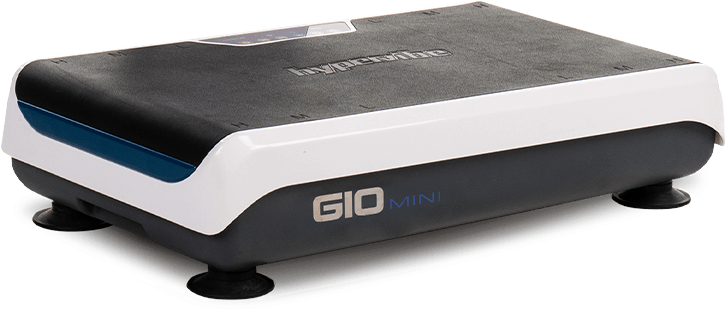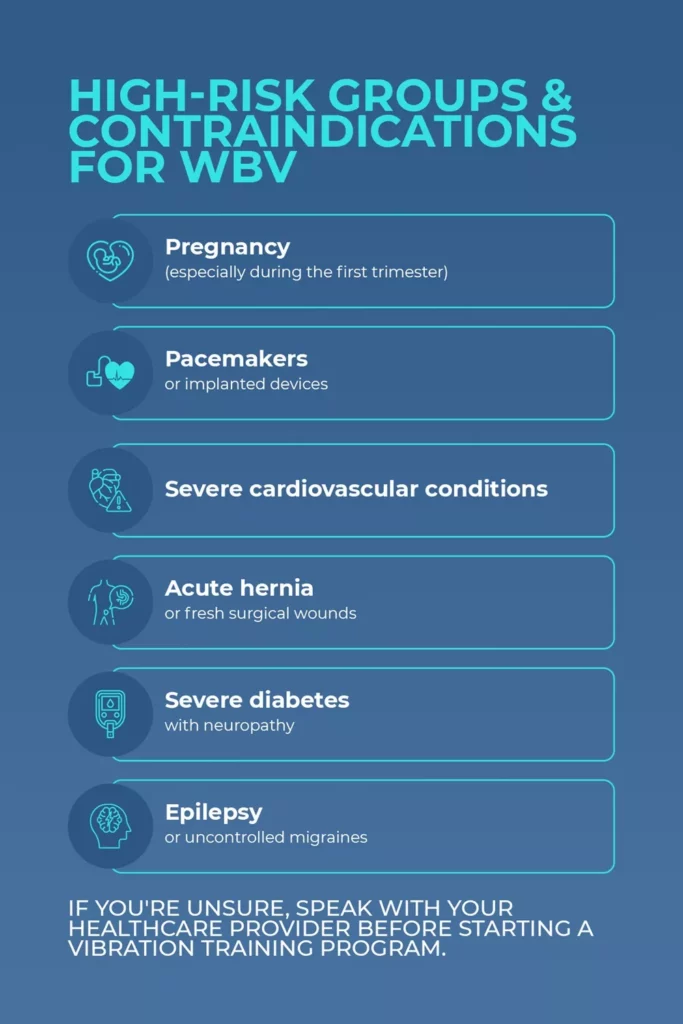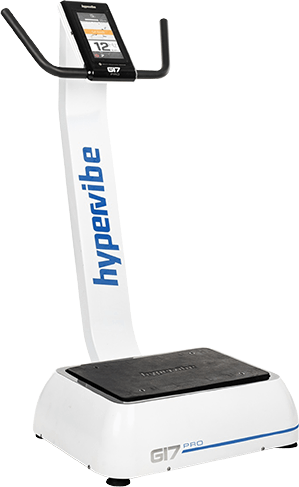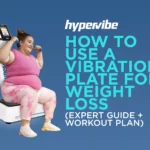
Are vibration machines bad for you? Yes, if used incorrectly.
But if used properly, Whole Body Vibration (WBV) has many benefits.
Randomized controlled trials have shown that WBV can, among other things, improve weight loss, increase bone density, improve muscle strength, enhance mobility/flexibility, improve lymphatic function and circulatory system health, and balance training.
Whole Body Vibration isn’t inherently harmful, but the response is settings dependent.
Improper use increases risk, especially when contraindications exist.
How to Use WBV Safely?





WBV Training is mostly anaerobic, making it a great alternative to most traditional resistance exercise programs.
It does not replace cardiovascular endurance exercise such as long-distance running or cycling.
WBV burns calories and aids in weight loss, but can limit your overall results if you treat it like a quick fix.
For best results, you must maintain a proper diet and manage stress.
Whole Body Vibration should be paired with proper nutrition, cardiovascular training, and medical interventions in extreme cases of obesity.
It also requires consistent use to be effective.
Risk may rise when training settings are adjusted too fast: frequency (Hz), amplitude, G-Force and the total time using the plate.
Higher-intensity programs and longer sessions increase the likelihood of side effects, whereas lower-intensity exposure has a safer profile.
Most physically fit people, or those without medical conditions, are fine during and after WBV, but some with health concerns can experience dizziness, headaches, back or joint discomfort, digestive upset, or motion sickness, especially when training improperly.
Home platforms can be pricey, take up floor space, and generate noise.
Expect a learning curve to understand specs (Hz, amplitude, g-force) and how they translate to safe, progressive sessions.

Not everyone is a good candidate for vibration training—some people should skip it altogether.
While we have already discussed the benefits of WBV, here’s a quick look at the most studied vibration training benefits, along with links to landmark research:
When beginning, the best results come from:
WBV can cause certain common and transient effects:

WBV can trigger short-term side effects, especially when intensity, posture, or session length are off.
These are more likely with higher intensity, poor body alignment, or strenuous sessions.
Outcomes also vary by platform mechanics (vertical vs. pivotal vs. tri-planar) and build quality (motor, amplitude control, g-force range).

Choosing whether whole body vibration is right for you starts with understanding both benefits and risks.
Many beginners notice muscle soreness, itchiness, tingling, increased skin temperature, or mild transient headaches during or shortly after a session.
These vibration plate side effects are more likely at higher training intensities and when you hold tension in your body or position yourself poorly (slumped, locked knees or elbows, etc.).
What to do: reduce intensity, correct your positioning, relax your body, shorten training bouts (20–45 seconds), and add longer rest periods.
Stop if symptoms persist.
Knees, hips, or the low back can ache if stance or g-forces are not optimal for you, especially with hyperextended knees or long continuous bouts with bad posture.
What to do: use soft knees and elbows, appropriate foot or hand placement, and short bouts (total 5–10 minutes for starters).
Progress slowly and prioritize pain-free ranges.
If discomfort exceeds mild muscle fatigue, reduce the training intensity or take longer breaks between sessions.
Occupational research links prolonged daily vibration exposure (far longer/harsher than consumer sessions) to nerve and cardiovascular problems—highlighting that settings and duration matter.
What to do: if you have vascular, cardiac, neurological, or migraine conditions, get medical guidance first, start with the lowest settings, and discontinue immediately if any of the following red-flag symptoms occur:





“Dose” in Whole Body Vibration (WBV) comes from how you set and use the machine: frequency (Hz), amplitude (mm), acceleration (g-force), and time on the platform.
Frequency sets how fast the platform moves; amplitude adjusts how far it moves at that frequency.
Time determines how long you train.
G-force is the plate’s acceleration and the resistance your body experiences (a function of frequency and amplitude).
Good technique (soft knees, neutral spine, relaxed neck/shoulders, and a stable grip when needed) reduces unwanted transmission to the head and spine.

Start low, focus on form, and progress gradually when introducing whole body vibration.
Begin conservatively, then progress by small steps:
High settings (greater frequency, amplitude, G-force, long continuous bouts, poor posture) raise side-effect risk.
Choose platforms that publish tested frequency, amplitude, and g-force ranges and allow fine dose control; use handrails for stability when needed.
Match g-force to your goal, but start low and build.
Technique and control matter more than cranking settings on day one.

Certain medical conditions make whole body vibration unsafe—always clear it with your healthcare provider first.
According to clinical insights and leading fitness studies, Vibration Training should be avoided by individuals with a number of conditions.
The most common ones are
If you’re unsure, speak with your healthcare provider before starting a Vibration Training program.
Vibration training works by leveraging the body’s natural responses to mechanical vibration, making it an efficient workout method.
This not only affects your muscles and joints but also the vestibular, connective tissue, and cardiovascular systems.
Local devices (e.g., handheld massagers, percussion heads, and belts) focus stimulation on a specific region with a lower overall systemic effect.
They can be useful for short bouts of localized relief or activation, but overuse or pressing on sensitive structures can irritate superficial nerves or cause bruising, especially over bony areas or in people with fragile skin.
For Whole Body Vibration (WBV), focus on body alignment and training intensity; for local tools, use light-to-moderate pressure, keep sessions brief, and move the device continuously rather than “parking” it on one spot.
Start with a clinician-reviewed contraindications checklist and a simple plan for dose (short bouts, equal rest, body alignment, slow progression).
Keep in mind: risk rises with dose, and evidence is goal-specific.
Ask your health or medical professional if they can help provide guidance.
LIV (low-intensity vibration) uses tiny displacements/very low g-force, while Whole Body Vibration (WBV) has larger displacements/potentially high g-force.
Use the vibration plate to support weight loss, improve balance, and activate muscles.
However, it should complement a calorie-deficit diet plus progressive cardio training.
Technique is important: keep your knees/elbows slightly bent, your spine neutral, your neck/shoulders relaxed, and get handrail support if needed.
This will help keep you safe and reduce the risk of pain or new injury.
Get clearance first if you have a pacemaker, arrhythmias, uncontrolled blood pressure, vascular issues, or any other contraindications.
Start at the lowest settings, use short bouts with equal rest, and monitor how you feel (palpitations, chest pain, unusual shortness of breath, calf swelling).
Stop and seek care if any of these happen. Space sessions on nonconsecutive days and only progress if you’re symptom-free.
During pregnancy, do not use vibration platforms.
Postpartum, return only with medical clearance.
Begin with the lowest dose, and prioritize balance and safety.
Make safety automatic: handrails on, stable shoes, and supervised mount/dismount if balance is uncertain.
Prefer short, frequent sessions.
On oscillating plates, stand closer to the center (lower amplitude) when starting.
Keep your eyes forward and knees soft, and only make the stance more challenging when you’re comfortable.
Translate specs into dose control you can actually use:
Prioritize machines with verified ranges, clear setting controls, and handrails.
What matters most is controllability and technique—not the biggest number on a brochure.
If you like comparisons, use a simple calculator that maps frequency and amplitude to approximate g-force so you can compare models like-for-like (e.g., Hypervibe vs. others) instead of brand claims.





The main drawbacks are
Many companies don’t verify their specifications, leading to lackluster results.
Short sessions help control dose (frequency, amplitude – g-force – time).
Longer exposures raise the likelihood of discomfort.
Start with brief bouts and equal rest; progress only if symptom-free.
People with recent or active blood clots, cardiovascular disease (recent MI/Stroke), uncontrolled hypertension, arrhythmias, pacemakers/cochlear implants, recent joint replacements, spinal fracture, severe dizziness/inner-ear problems, and pregnancy should avoid WBV or seek medical clearance first.
Likely a problem with incorrect settings or poor posture: locked knees, deep angles, high G-force, or long continuous bouts can aggravate joints.
Reduce frequency/amplitude, use a soft-knee stance, shorten bouts, and add rest.
Stop if pain persists or worsens.
WBV stimulates the vestibular system (inner ear).
Most users tolerate brief, low-intensity sessions, but rare cases link vibration to benign paroxysmal positional vertigo (BPPV) and dizziness.
Avoid head/neck exposure, keep bouts short, and stop if vertigo or visual changes.
For most healthy adults using moderate settings, WBV has not been shown to acutely strain the heart; small studies and meta-analyses even report reduced arterial stiffness and modest blood-pressure improvements over time.
That said, people with arrhythmias, pacemakers, or uncontrolled hypertension should get clearance and follow conservative dosing.
Exercise-related itching often reflects histamine-mediated vasodilation as circulation ramps up.
It’s typically harmless but can feel intense when you’re new or if settings are high.
Ease frequency/amplitude, keep knees soft, and hydrate.
If itching is persistent or accompanied by hives or breathing symptoms, seek care.
Not inherently, but improper technique or high settings can aggravate knees, hips, and the low back.
Err on the side of shorter, well-coached sessions.
Headaches and lightheadedness are common dose-related symptoms—often from higher frequencies/amplitudes or bracing the neck/locking the knees (more head/vestibular transmission).
Lower the settings, unlock the knees, relax the shoulders/neck, shorten bouts, and rest longer.
Stop if symptoms persist.
Short-term studies show neutral to slightly lower post-exercise blood pressure with WBV, and a meta-analysis reports improved arterial metrics after programs of several weeks.
People with hypertension should still seek clearance and monitor response closely.
Occupational/long-duration exposure has been linked with vascular complaints, but these scenarios involve much higher daily doses than consumer WBV.
Use conservative settings and short sessions, especially if you have vascular disease.
Get medical clearance first if you are at risk of vascular complications.

Here’s how we use a vibration plate for weight loss...

Many people, especially beginners, notice an itchy or tingling “pins-and-needles”...

Taking into consideration the growing popularity of the vibration plate,...

The lymphatic system, also called the lymphoid system, is an...

Are vibration machines bad for you? Yes, if used incorrectly....